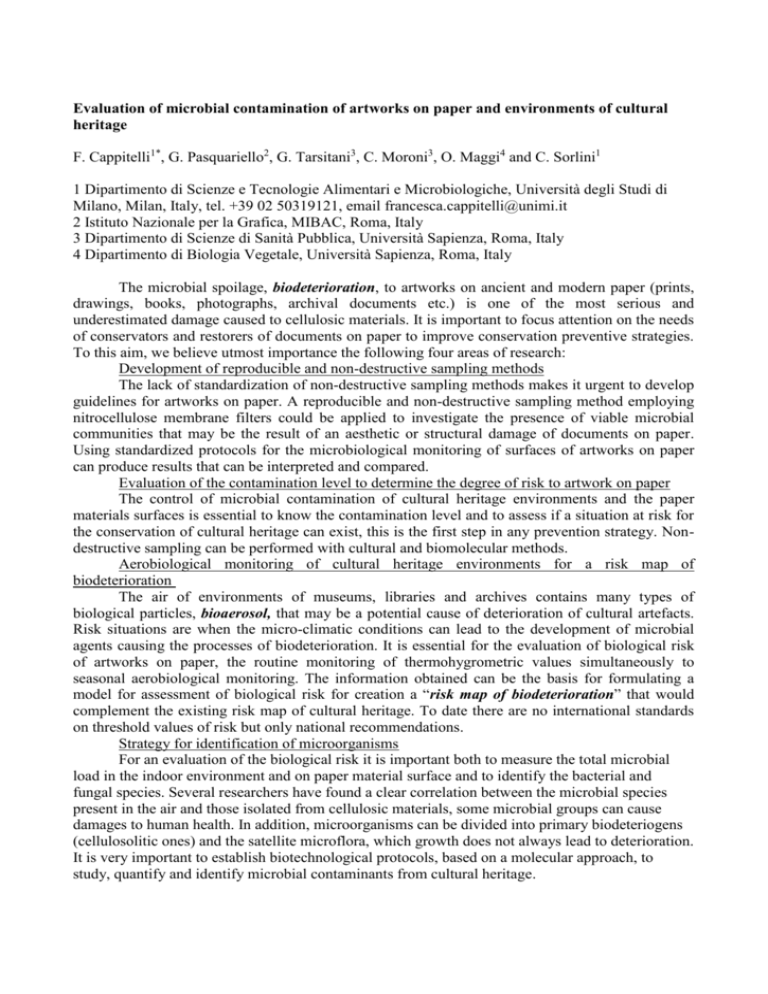Evaluation of microbial contamination of paper
advertisement

Evaluation of microbial contamination of artworks on paper and environments of cultural heritage F. Cappitelli1*, G. Pasquariello2, G. Tarsitani3, C. Moroni3, O. Maggi4 and C. Sorlini1 1 Dipartimento di Scienze e Tecnologie Alimentari e Microbiologiche, Università degli Studi di Milano, Milan, Italy, tel. +39 02 50319121, email francesca.cappitelli@unimi.it 2 Istituto Nazionale per la Grafica, MIBAC, Roma, Italy 3 Dipartimento di Scienze di Sanità Pubblica, Università Sapienza, Roma, Italy 4 Dipartimento di Biologia Vegetale, Università Sapienza, Roma, Italy The microbial spoilage, biodeterioration, to artworks on ancient and modern paper (prints, drawings, books, photographs, archival documents etc.) is one of the most serious and underestimated damage caused to cellulosic materials. It is important to focus attention on the needs of conservators and restorers of documents on paper to improve conservation preventive strategies. To this aim, we believe utmost importance the following four areas of research: Development of reproducible and non-destructive sampling methods The lack of standardization of non-destructive sampling methods makes it urgent to develop guidelines for artworks on paper. A reproducible and non-destructive sampling method employing nitrocellulose membrane filters could be applied to investigate the presence of viable microbial communities that may be the result of an aesthetic or structural damage of documents on paper. Using standardized protocols for the microbiological monitoring of surfaces of artworks on paper can produce results that can be interpreted and compared. Evaluation of the contamination level to determine the degree of risk to artwork on paper The control of microbial contamination of cultural heritage environments and the paper materials surfaces is essential to know the contamination level and to assess if a situation at risk for the conservation of cultural heritage can exist, this is the first step in any prevention strategy. Nondestructive sampling can be performed with cultural and biomolecular methods. Aerobiological monitoring of cultural heritage environments for a risk map of biodeterioration The air of environments of museums, libraries and archives contains many types of biological particles, bioaerosol, that may be a potential cause of deterioration of cultural artefacts. Risk situations are when the micro-climatic conditions can lead to the development of microbial agents causing the processes of biodeterioration. It is essential for the evaluation of biological risk of artworks on paper, the routine monitoring of thermohygrometric values simultaneously to seasonal aerobiological monitoring. The information obtained can be the basis for formulating a model for assessment of biological risk for creation a “risk map of biodeterioration” that would complement the existing risk map of cultural heritage. To date there are no international standards on threshold values of risk but only national recommendations. Strategy for identification of microorganisms For an evaluation of the biological risk it is important both to measure the total microbial load in the indoor environment and on paper material surface and to identify the bacterial and fungal species. Several researchers have found a clear correlation between the microbial species present in the air and those isolated from cellulosic materials, some microbial groups can cause damages to human health. In addition, microorganisms can be divided into primary biodeteriogens (cellulosolitic ones) and the satellite microflora, which growth does not always lead to deterioration. It is very important to establish biotechnological protocols, based on a molecular approach, to study, quantify and identify microbial contaminants from cultural heritage.







